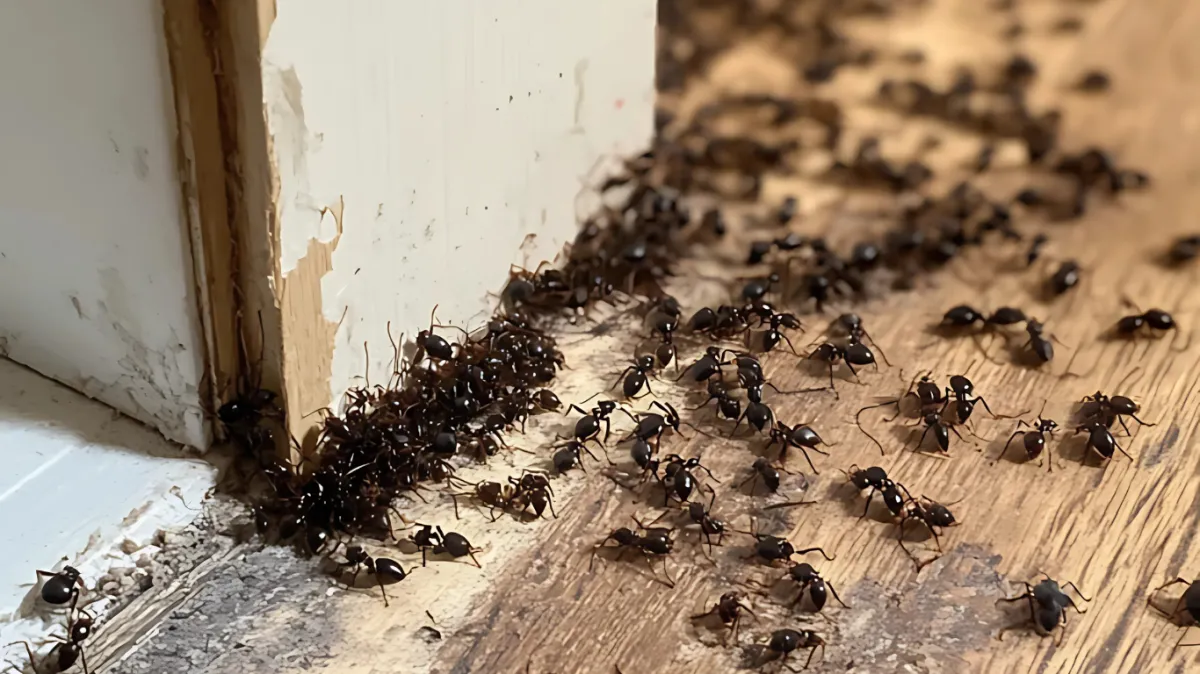
The Cobble Hill Pest Journal
The Cobble Hill Pest Control Journal

Ants and Termites in Sooke: Tiny Pests, Major Problems
Understanding the Invaders
Carpenter Ants
Carpenter ants are large ants known for tunneling through wood to build their nests—not eating it. Their presence can lead to serious structural damage over time.
Typically black or red-black and up to 1.3 cm long
Nest in moist or decaying wood such as decks, wall voids, or window frames
Leave behind sawdust-like frass near nesting sites
Can cause significant structural weakening if left untreated
Thrive in Sooke's damp conditions, especially in coastal or forest-adjacent properties
Pavement Ants
Smaller and more of a nuisance than a threat, pavement ants still commonly invade homes and contaminate food sources.
Small, dark brown to black with pale legs, usually 2.5–4 mm in size
Nest in cracks of sidewalks, driveways, foundations, or under concrete slabs
Forage indoors for sweets, greasy foods, and crumbs
Create visible ant trails along baseboards and kitchen counters
May appear in large numbers if left unchecked
Odorous House Ants
These ants earn their name from the unpleasant smell they emit when crushed and are known for persistent infestations.
Small, dark brown to black ants about 2.5–3 mm long
Release a strong, rotten coconut-like odor when crushed
Commonly nest in wall voids, beneath flooring, and near moisture sources like leaky pipes
Often seen foraging for sugary foods in kitchens and pantries
Can be difficult to control due to their ability to relocate quickly and form multiple colonies
Termites
Subterranean termites are among the most destructive pests homeowners in Sooke can face, often causing damage that goes undetected until it's severe.
Pale or cream-colored with soft bodies; swarmers have wings and resemble flying ants
Feed on cellulose found in wood, paper, and drywall
Create mud tubes along walls or foundations to travel between nest and food source
Signs of activity include hollow-sounding wood, discarded wings, or bubbling paint
Sooke's moist soil and wooded surroundings make homes especially vulnerable to termite infestations
Why Early Action Matters
Structural Risk
Carpenter ants and termites are not just a nuisance—they are a threat to your home’s foundation and long-term safety.
Carpenter ants tunnel through wood, weakening beams, joists, and framing over time.
Subterranean termites silently consume structural wood from the inside out, often going unnoticed until major damage is done.
Left untreated, both pests can lead to sagging floors, warped walls, and costly structural repairs.
Early inspections help identify vulnerabilities before they turn into major restoration projects.
Indoor Invasions
Odorous house ants and pavement ants can take over kitchens and bathrooms if not addressed promptly.
Odorous house ants are attracted to sweet substances and moisture sources, making kitchens and bathrooms high-risk areas.
Pavement ants often invade through foundation cracks, establishing nests under floors and inside wall voids.
Both species can form multiple satellite colonies, making infestations harder to control if allowed to spread.
Food contamination, hygiene concerns, and visible ant trails become daily frustrations for homeowners.
Cost Efficiency
The longer a pest issue persists, the more complicated—and expensive—it becomes to solve.
Treating ants and termites early requires fewer visits and less product, reducing service costs.
Proactive pest control helps prevent secondary damage, such as water leaks from termite-damaged plumbing supports.
Quick action minimizes disruption to your household routine and avoids potential relocation during extensive repairs.
Early intervention also reduces the need for repeated treatments or follow-up visits down the line.
Pest in the City's Proven Approach
Step 1: Professional Inspection
Our team conducts a detailed assessment of your property—inside and out—to identify ant trails, nests, and potential termite damage.
Step 2: Targeted Treatment Plan
We customize every solution. For ants, this may include gel baits, non-repellent sprays, and barrier applications. For termites, we offer soil treatments and baiting systems designed for long-term elimination.
Step 3: Safe Implementation
All treatments are family- and pet-friendly. We use environmentally responsible products and apply them with precision to minimize impact on your living space.
Step 4: Ongoing Monitoring
We schedule follow-ups to ensure treatments are working and offer long-term protection with preventive maintenance, sealing off entry points and advising on moisture control.
How You Can Help
Taking preventative steps around your home can significantly reduce the risk of ant and termite infestations. Here’s what you can do to support a pest-free environment:
Seal Entry Points
Inspect and seal all cracks and gaps around windows, doors, and foundation walls using caulk or weatherstripping.
Repair damaged screens and ensure door sweeps are intact to block insect entry.
Pay close attention to utility entry points, such as where pipes and wires enter the home—these are common access routes for ants.
Reduce Moisture Around the Home
Fix leaky pipes, faucets, and appliances, particularly in moisture-prone areas like kitchens, bathrooms, basements, and crawl spaces.
Use dehumidifiers in damp areas to discourage wood-nesting pests like carpenter ants and termites.
Ensure gutters and downspouts direct water away from your foundation to prevent wood rot and moist soil, which attract termites.
Maintain Cleanliness Indoors
Wipe up spills immediately and sweep or vacuum food crumbs regularly, especially in eating areas.
Store dry goods in airtight containers to avoid attracting ants into pantries and cabinets.
Clean under appliances and behind furniture, where food debris often goes unnoticed but can still attract pests.
Practice Outdoor Maintenance
Keep mulch, compost, and woodpiles at least 12–18 inches away from your home’s foundation to limit shelter for ants and termites.
Trim shrubs and trees to prevent branches from touching the exterior of your house—these can act as highways for ants.
Avoid stacking firewood directly against your home or leaving construction lumber exposed to the elements.
Call the Professionals at the First Sign
If you notice signs of activity—such as ant trails, frass (sawdust-like material), soft wood, or mud tubes—don’t wait.
Contact Pest in the City promptly to assess and address the issue before it spreads.
Our team provides thorough inspections, safe treatments, and follow-up services to ensure complete resolution and peace of mind.
Whether it’s a colony of ants trailing into your kitchen or termites gnawing silently behind the walls, Pest in the City in Sooke is ready to help. Our experienced team delivers fast, effective, and eco-friendly pest control solutions tailored to your home and your environment.
Let us safeguard your property—so you can enjoy your summer worry-free.
Visit our website from more information [https://pestinthecity.com/home]

Schedule a Pest Inspection
Ready to schedule a pest inspection? Contact us today.

